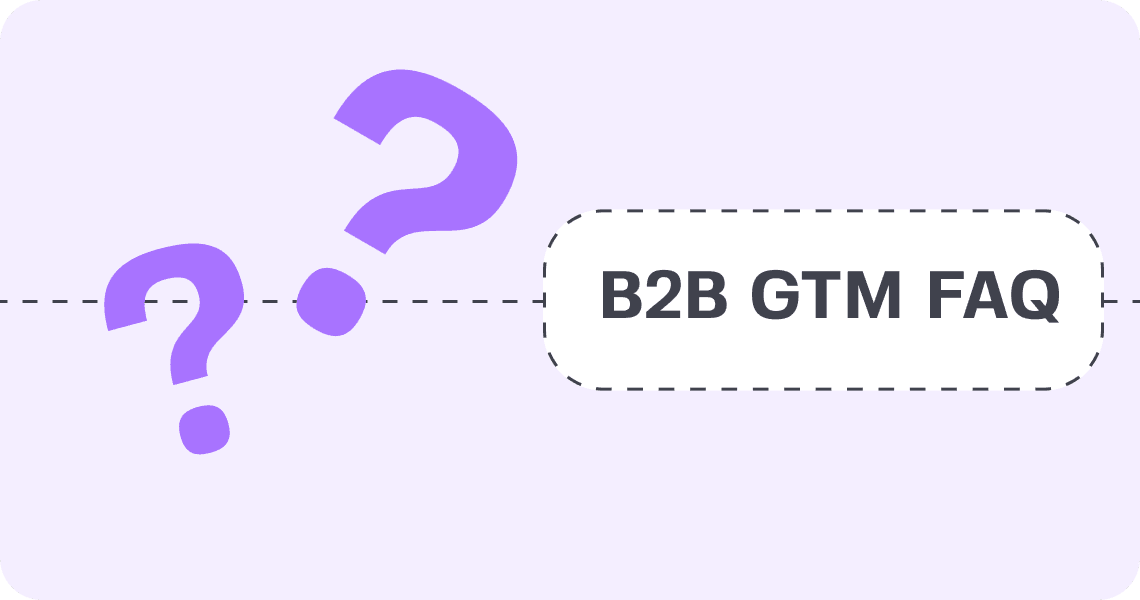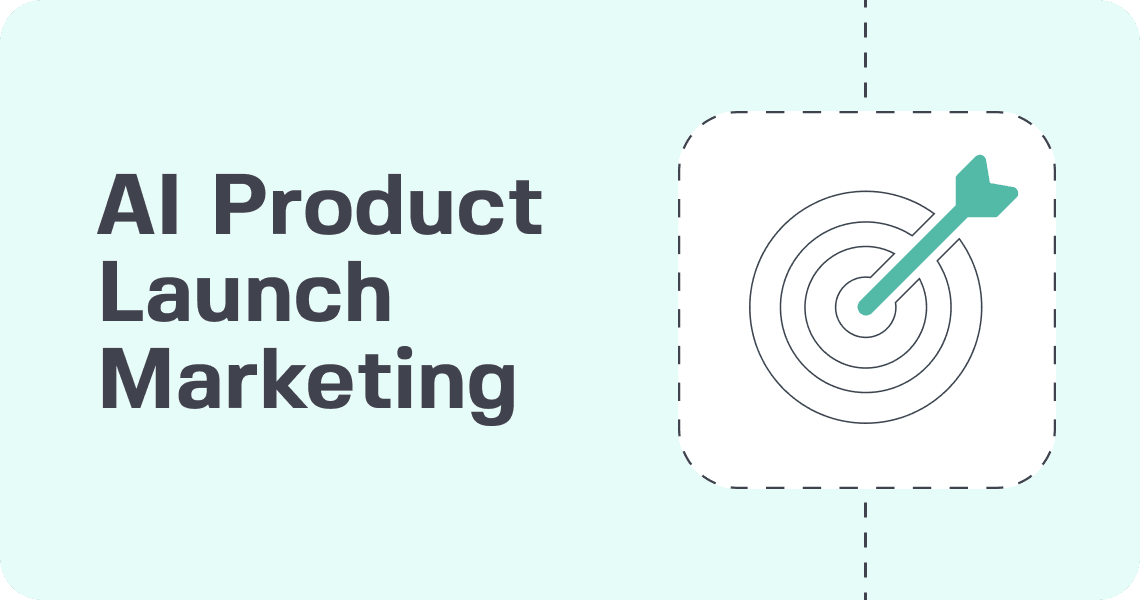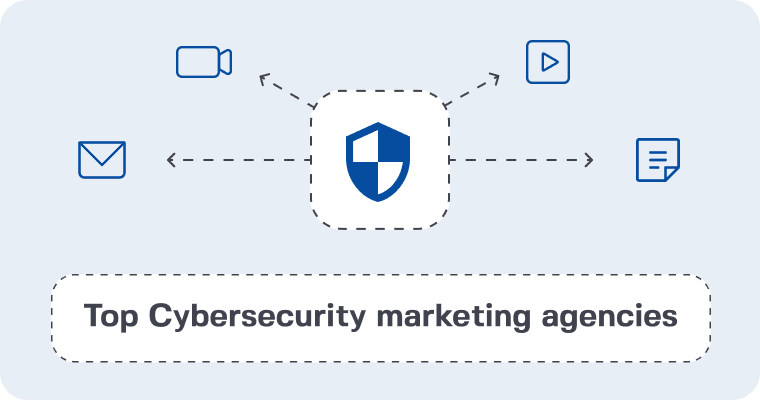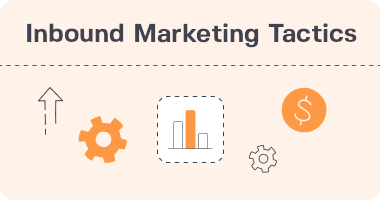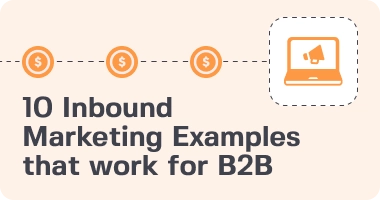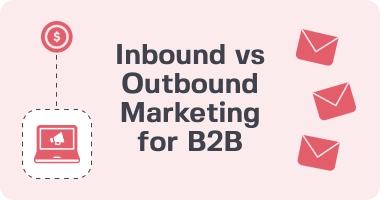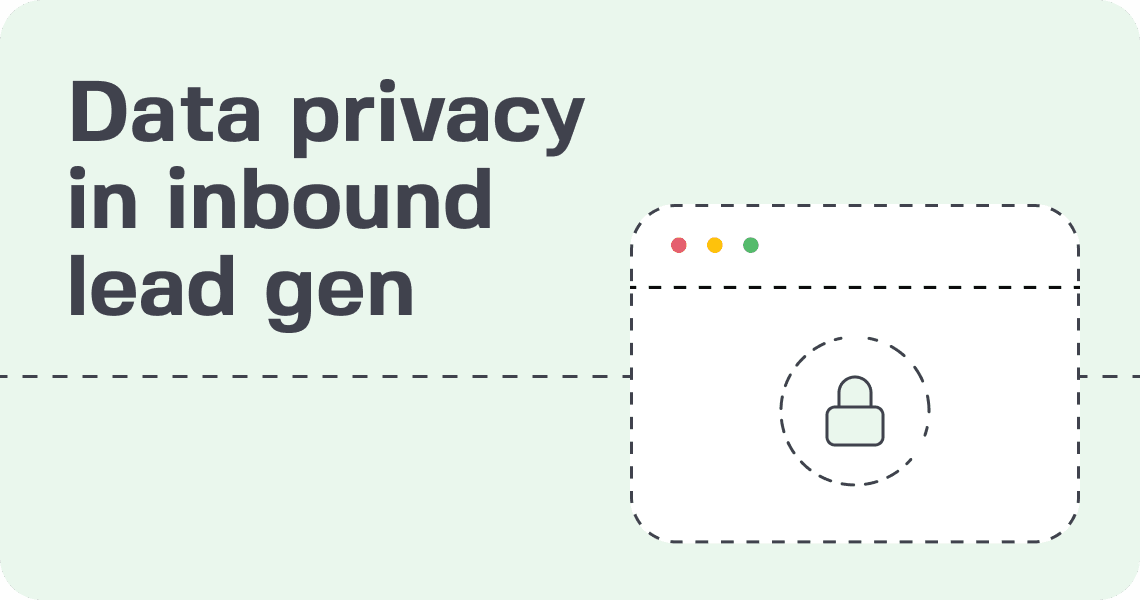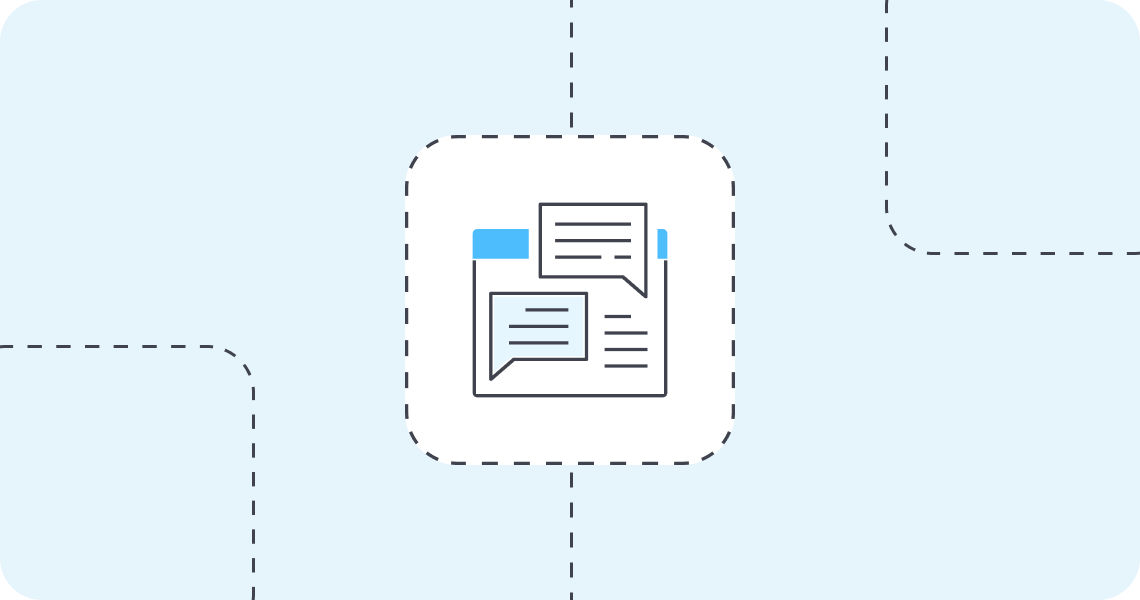Demand generation focuses on building interest and awareness for a product or service. It involves collecting information about potential customers to follow up with later.
While lead generation lays the groundwork with a narrower focus through targeted campaigns, it often utilizes content and experiences to cultivate early-stage interest over time.
Lead generation further narrows this focus, implementing tactics such as forms or gated content to help you zero in on ideal prospects.
Both are necessary for a holistic marketing strategy, creating awareness and accelerating conversions in the most productive way for your business.
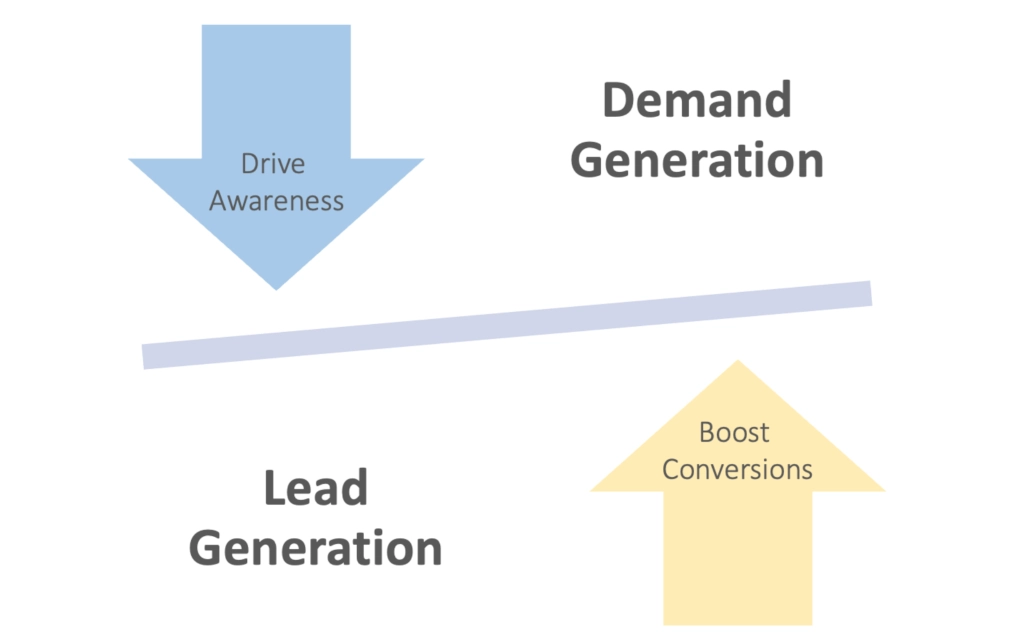
What Is Demand Generation
Demand generation is a holistic, long-term, strategic approach to marketing. It creates awareness and generates interest for a product or service within a specific audience. It’s not immediately about closing a sale. Rather, it paves the way by establishing valuable relationships that lead prospects down the path to purchase.
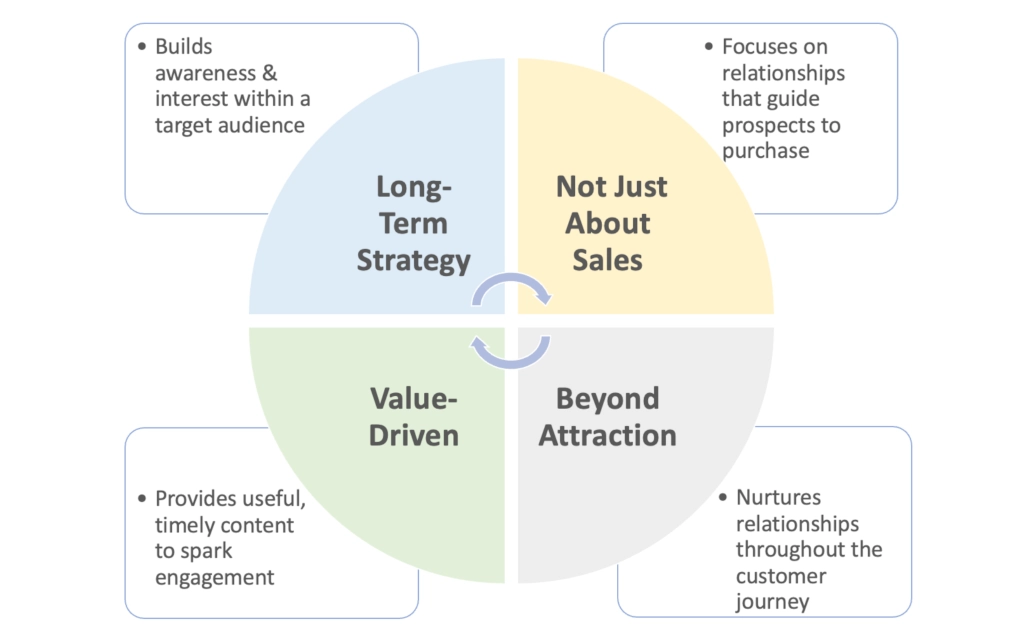
By offering useful, timely, and interesting information, demand generation ignites interest and helps establish a company as a go-to authority. One of its biggest misconceptions is the role it plays beyond just attracting attention—it’s an engine that continues to nurture relationships at every stage of the customer journey.
Definition of Demand Generation
At its soul, demand generation is not about the quick win. It’s about the long game and building sustained interest. Where lead generation is concerned with getting contact information for later outreach, demand generation is all about brand awareness and education. It’s more about addressing the pains that leads were unaware they had in the first place.
You educate them on the impact that a product or service can have on their life. For example, a company that sells project management software might create blog content aimed at improving team collaboration. They could even conduct webinars to pass down best practices in time management.
These initiatives are aimed at positioning the brand as an educational authority and thought leader within its industry. Second, they do not intend to sell the software outright. In doing so, it helps to prompt prospects to make the initial move toward engagement.
Demand generation isn’t just linked to one specific tactic. With demand generation, you can leverage exciting and innovative tactics to attract, nurture, and convert potential customers. These approaches can involve content marketing, social media campaigns, email outreach, and even paid advertising.
The ultimate aim is to engage audiences in their own spaces, all while establishing trust and credibility.
Goals of Demand Generation
The main goal of demand generation is to create a steady and sustainable flow of inbound interest in a brand’s offerings. Curiosity usually starts with low-hanging fruit. For one thing, people may engage with a brand by liking them on social media or subscribing to an email newsletter.
Each encounter increases their awareness and trust, setting them up for future sales discussions. A second primary goal is to make sure that when prospects do get handed off to the sales team, they’re more educated and already warmed up.
It’s no wonder research indicates that 81% of buyers conduct their own brand research prior to engaging. It emphasizes the need for enabling future customers with the information necessary to make informed decisions with confidence.
Ultimately, for long-term strategy, demand generation is about cultivating brand loyalty. By continually providing true value with high-quality content and overall positive experiences, businesses will earn the trust of their audience and create long-term relationships.
This fosters a community of customers who advocate for the brand as much as they buy from it.
Scope of Demand Generation
Demand generation encompasses many channels and tactics, all of which contribute uniquely to the process of educating and engaging prospects. Social media channels are the perfect place to promote this type of quick, compelling content that grabs people’s attention.
At the same time, effective SEO helps these educational blog posts and resources be more discoverable. Paid advertising can have an incredible impact on amplifying these efforts by pushing this content and messaging to audiences who may not be aware of the brand yet.
Content marketing is the backbone of demand generation. Purposeful thought leadership pieces, like whitepapers and webinars, provide deeper knowledge. Brand awareness assets, such as infographics and short-form video, distill complicated issues into easily digestible information.
For example, an e-commerce brand might create a series of how-to guides, helping users solve common problems while subtly showcasing its products.
What Is Lead Generation
Lead generation is a highly strategic process. It all boils down to attracting and engaging qualified leads — potential customers who are most likely to make a purchase. This strategy engages and explicitly seeks out people or companies that are interested.
It takes that new interest and turns it into actionable sales opportunities for your teams to pursue. Unlike demand generation, which casts a broader net to create awareness and interest, lead generation hones in on immediate engagement and seeks to establish direct contact with potential clients.

This important distinction enables businesses to better meet unique needs and nurture leads deeper down the buyer’s journey.
Definition of Lead Generation
At its most basic, lead generation is the process of turning a prospect’s initial interest into a tangible lead that sales teams can go after. The journey usually starts with collecting some form of contact information, which you can do with strong CTAs built into your high-value content.
A clear call to action, such as “Sign up for a free trial,” encourages leads to take the next step. In exchange, they get important information or resources in return if they provide their information.
In turn, this often gives businesses the opportunity to start nurturing these leads with relevant solutions, content and offers. Cold calling and networking are still key to lead generation.
Digital strategies are quickly rising to the forefront and changing the way organizations across all industries approach lead generation. Techniques such as publishing SEO-optimized content, running targeted ad campaigns, and offering gated resources like webinars or case studies are commonly used.
For example, a white paper or e-book explaining the latest industry trends could ask readers to provide their email address before downloading the report. All of these efforts ensure lead generation is at the head of a productive sales pipeline. Because of this, teams always have a pipeline of highly-qualified leads at the ready.
Goals of Lead Generation
The ultimate purpose of lead generation is to save a business money by widening their audience, all the while boosting chances at sales. Maintaining the sales pipeline with a steady stream of qualified leads is making or breaking companies’ fortunes.
Ultimately, this strategy aims to convert prospects into repeat, loyal customers. For instance, providing customized incentives or one-on-one support can help close the gap and push prospects further down the sales funnel.
Lead generation goes together with demand generation. If demand generation builds the top of the funnel interest, lead generation makes sure it converts that interest into tangible opportunities.
Combined, each of these areas reinforces the others to help maximize success for the business as a whole.
Scope of Lead Generation
Lead generation strategies often involve developing an understanding of perfect clients, fostering impactful collaborations, and penetrating underserved markets. This usually includes creating customized sales decks or sales presentations that focus on each prospect’s unique pain points.
For instance, a technology firm focused on small business could promote affordable IT solutions designed specifically for new ventures. Opening new markets to play this huge part is the other big piece.
By deeply researching trends and analyzing how their audience is behaving, businesses can find unexpected opportunities they hadn’t thought of before. To be effective, you must have a clear understanding of your ideal buyer persona.
That understanding equips you to connect each lead generation effort to your organization’s larger objectives.
Key Differences Between Demand and Lead Generation
Knowing the difference between demand generation and lead generation is key when developing a successful marketing plan. Both are important, but each serves its own function in fueling business growth.
Here’s a deeper look at their differences in terms of focus, audience engagement, buyer’s journey, metrics, and outcomes.
1. Focus and Objectives
| Aspect | Demand Generation | Lead Generation |
| Objective | Build brand awareness and engagement. | Convert prospects into actionable leads. |
| Focus | Long-term growth and sustained visibility. | Short-term conversions and measurable wins. |
Demand gen is more about creating awareness by presenting the brand to a larger target market. The ideal outcome is to generate curiosity and dialogue. We do this through targeted social media campaigns, educational content, and vigorous outreach at conferences and events.
Lead generation focuses on turning that interest into qualified leads. It’s about collecting contact information and finding the leads that are most qualified and looking to move to the next level. This narrow view of lead gen usually involves tactics such as gated content, email newsletter sign-ups, and form fills.
If you want to be successful across the board, it’s necessary to get these strategies aligned. Demand generation sets the stage, lead generation plays to the audiences that are already ready to go.
2. Target Audience and Approach
Demand generation has a broader focus, seeking to educate and inform an audience without the short-term, transactional intent. It leverages blog posts, webinars, and videos to build curiosity and trust.
Things like website traffic or newsletter sign-ups are often touted as the holy grail of effective demand generation. Lead generation takes a more targeted approach, reaching out to people who have already expressed interest.
This strategy would involve things like highly personalized emails or tailored calls to action. Anticipating audience preferences is essential for both strategies. Nurturing through educational content lays the groundwork for demand generation.
More targeted, proactive outreach is what directly fuels lead generation.
3. Role in the Buyer’s Journey
Demand generation works at the top of the funnel, focusing on early-stage awareness. It’s all about planting that seed and making sure that when potential buyers are ready, they know the brand is out there.
Lead generation is stimulating interest further down the funnel. So when a prospect engages with your demand generation initiatives, your lead gen tactics are effective at immediately seizing that intent.
This usually happens through passing MQLs, or Marketing Qualified Leads. Nurturing these leads through the journey is crucial to maximizing conversion.
4. Metrics for Success
Key metrics for evaluating success differ:
- Demand Generation: Website traffic, event registrations, content downloads.
- Lead Generation: Conversion rates, sales-qualified leads (SQLs), cost per lead (CPL).
By tracking these metrics on a regular basis, marketers can adjust tactics accordingly. With the right demand gen vs lead gen tweaks, you’ll be able to boost your engagement and conversion rates.
5. Timeframe and Outcomes
Demand generation delivers long-term brand equity. Though its results are slow to materialize, the benefits are steady and long-lasting.
Lead generation prioritizes short-term results, like generating SQLs to feed the sales pipeline. Finding the balance between these timelines will help set you up for both short-term wins and long-term growth.
How Demand and Lead Generation Work Together
Demand generation and lead generation are two different B2B inbound marketing tactics with specific functions. Their true power comes when you put them together.
Demand generation helps to build brand awareness and interest. Lead generation takes that interest and turns it into leads you can take action on. By strategically combining the two components, organizations can produce a powerful, effective marketing synergy.
This demand-centric approach focuses on attracting the right potential customers and effectively nurturing and converting them. Combined, these strategies create a more dynamic customer journey, improving efficiency and effectiveness.
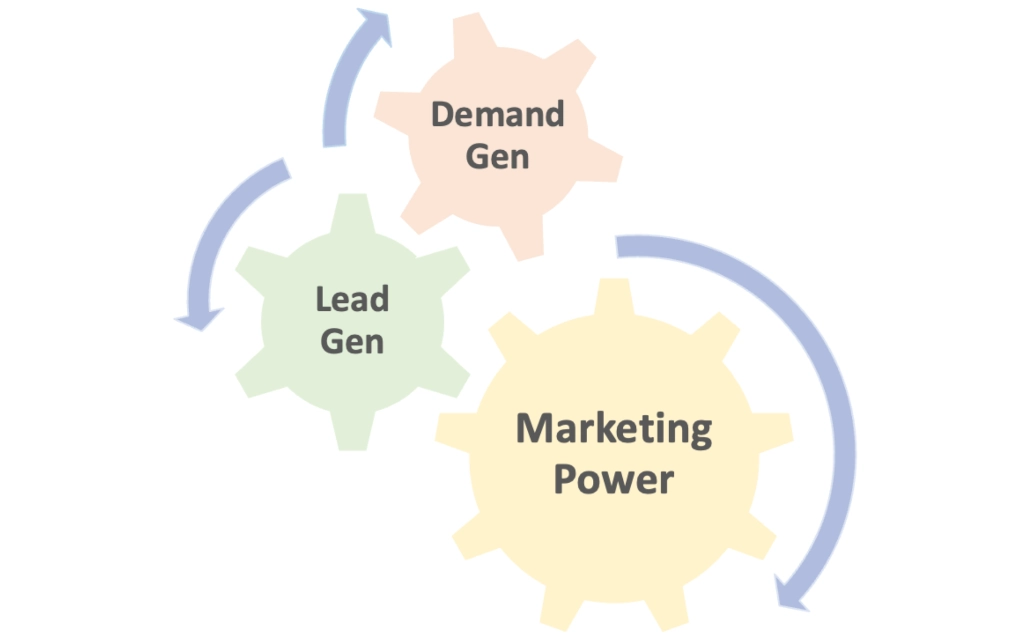
Aligning Strategies for Better Results
Aligning demand and lead generation efforts needs a go-to-market strategy that connects the dots between marketing and sales. Here are some key strategies to ensure alignment:
Marketing teams are in a prime position to collect data about customer preferences and behaviors. Sales teams have last-mile, frontline, qualitative knowledge of buyer objections, buyer journey, and decision-making processes.
Frequent communication and collaboration between these teams helps make data-driven adjustments that strengthen both demand and lead generation initiatives.
Develop integrated campaigns: Campaigns that combine elements of brand awareness and lead conversion are more effective in capturing attention and driving action. A webinar is a great way to demonstrate your expertise and create demand.
Simultaneously, it gives you the opportunity to capture their contact info to follow-up and create leads with lead generation. Performance data allows marketers to analyze what’s working and what’s not.
For example, if your email campaigns are getting great click-through rates but terrible conversions, you might need to focus on your messaging. A collaborative culture between marketing and sales enhances overall effectiveness.
When these teams collaborate, it can be easier to coordinate objectives and provide a unified message that flows seamlessly through every customer interaction. Both demand and lead generation should aim to achieve overarching business objectives.
That starts with establishing a set of common metrics, whether it’s customer acquisition cost or lifetime value, that indicate success.
Complementary Roles in Marketing
Demand generation tactics set the stage by building awareness and interest, thus enabling lead generation efforts to be more impactful. For instance, 98% of software buyers consult reviews prior to purchase.
It goes to show how much demand generation activities, like gathering testimonials or even creating case studies, can sway buyer decisions. By meeting buyer needs from the start, demand generation establishes credibility and helps ensure a brand will be considered among the best options available.
Lead generation takes all that interest and turns it into tangible, trackable actions. For most SaaS businesses, this means completing an action like scheduling a demo or signing up for a free trial.
When used in tandem, the complementary nature of these strategies helps create a seamless journey from awareness through to decision making, increasing the chances of conversion.
Balancing Short-Term and Long-Term Goals
A more balanced approach would be better for maintaining long-term growth. Demand generation fuels long-term brand building by keeping a company top-of-mind and culturally relevant.
That’s imperative because more than three in five software buyers already have an applicable brand in mind before they even start their search. In contrast, lead generation meets more short-term needs through interest-based targeting and converting leads to sales.
Establishing measurable goals for both demand and lead generation forces you to give attention to both strategies. For demand generation, the goal may be measuring the increase of traffic to your website or engagement on social media.
For lead generation, metrics such as conversion rates for your specific funnel or how many qualified leads you have are key. Combined, these tactics form a powerful marketing strategy that fulfills both short- and long-term goals.
Effective Tactics for Demand Generation
Demand generation is about creating awareness and interest towards your brand, products or services. It’s more than just finding new leads, it’s about building a platform for deeper, lasting connections.
An effective demand generation strategy stitches together many different tactics to reach audiences, introduce them to your organization, and drive them to take informed and purposeful actions. Further down, I’ll dive into some effective tactics that can go a long way in making those objectives a reality.
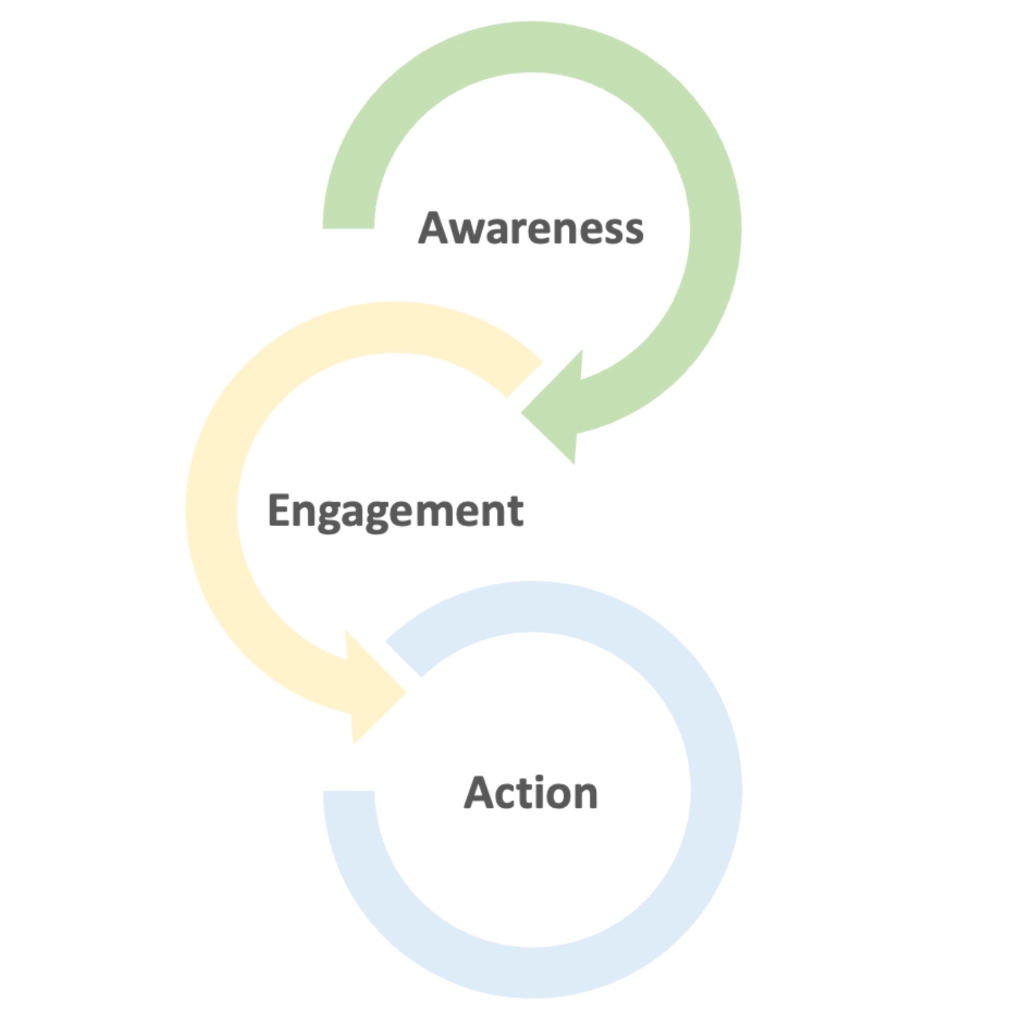
Creating Educational Content
Offering helpful educational material is one of the best ways to establish trust and credibility with your prospects. Providing in-depth resources like comprehensive guides and informative how-to posts can help establish your authority.
This helps to establish your brand as an industry authority. For example, a technology company could produce eBooks that help explain artificial intelligence’s recent trends. They could even contribute blog posts that would help address frequently encountered technical challenges.
This evergreen content continues to educate your audience and attract new visitors with smart SEO practices. Publishing effective, optimized articles or videos makes sure your content finds its way to the people searching for the solutions you provide.
For example, adopting specific keywords in line with what potential customers are asking can increase sight on search engines like Google. Long-term, regular educational content builds audience engagement, training potential audiences to think of your brand as a go-to resource.
Leveraging Social Media Channels
Additionally, social media platforms offer an easy-to-use, low-cost method to reach a large audience. Unicorn discovery channels LinkedIn, Twitter, and Facebook have changed the game for demand generation.
They allow brands to reach their ideal customers and target them in a meaningful way. Creating content that educates, amuses, or provides solutions creates a desire to share and ignites discussion.
For example, a healthcare company could use Instagram to post bite-sized wellness tips. Or they could share infographics on LinkedIn to showcase industry trends.
In this space, I don’t need to tell you how important consistency is. Consistently sharing relatable content, whether that’s behind-the-scenes videos, fun polls or Q&As, or customer successes, creates recognition.
Integrating paid campaigns through platforms like Facebook and LinkedIn can increase overall reach. By running these targeted ads, you make sure that your message is seen by only the most relevant people, which is the icing on the demand generation cake.
Hosting Webinars and Podcasts
Webinars and podcasts provide a highly engaging, informative, and even interactive channel to educate your audiences while positioning yourself as a thought leader. These formats are great for demystifying more complicated concepts, like adjusting for inflation in your financial plan or an overview of software features.
Webinars allow you to conduct real-time Q&A sessions to make them highly engaging, highly informative, and highly valuable. Your own SaaS company might decide to host a live demo of its platform. This exclusive event provides attendees with the opportunity to ask questions and see the product in action!
Podcasts offer a mobile platform for audiences to engage in education and entertainment wherever they are. A marketing agency could create a podcast discussing strategies to improve campaign performance, building trust while fostering a community of listeners.
Both formats build authority and foster long-term relationships with audiences.
Using Video Marketing for Awareness
Video content continues to be one of the most effective weapons in the demand generation arsenal. It piques interest immediately, distills complicated concepts, and most importantly, it sticks with them.
For example, an environmental nonprofit might create a quick animated video showing how recycling actually operates. They could further illustrate their real-world impacts by personalizing the case studies with customer stories.
Optimizing long and short-form video content for channels such as YouTube, Instagram, and TikTok helps you reach audiences of all kinds. Quick, smart, cheeky little clips do great on social media platforms!
Longer videos tend to be better hosted on YouTube or your website. Adding visible CTAs to your videos—such as “Learn More” or “Download Our Guide”—will help prompt your viewers to take action.
Running Demand-Focused Advertising
Targeted advertising helps connect the dots from awareness to action. With platforms like Google Ads and Facebook Ads, brands can easily target their ideal demographics.
Writing effective ad copy combined with captivating visuals can create a sense of urgency and get people to click through to your site. For example, a travel e-commerce brand could advertise seasonal offers or new destinations available on their platform.
To guarantee that success, testing and optimizing on the fly is necessary. Tracking metrics such as click-through rates (CTR) and conversion rates shows what’s effective and what’s not.
With this knowledge, you’re better equipped to make data-driven adjustments in a more effective way. Pairing paid ads with organic efforts such as SEO and gated content provides a holistic, balanced strategy to demand generation.
Effective Tactics for Lead Generation
Lead generation is the process of converting potential interest into tangible business opportunities through the exchange of contact information and qualification of interested prospects. It’s an important part of turning website visitors, or future customers, into sales-ready leads.
With an effective combination of tactics targeted to the right audiences, businesses can cut through the noise and clutter to drive attention and measurable conversions. Here are the best lead generation tactics in order of effectiveness, with in-depth analysis.
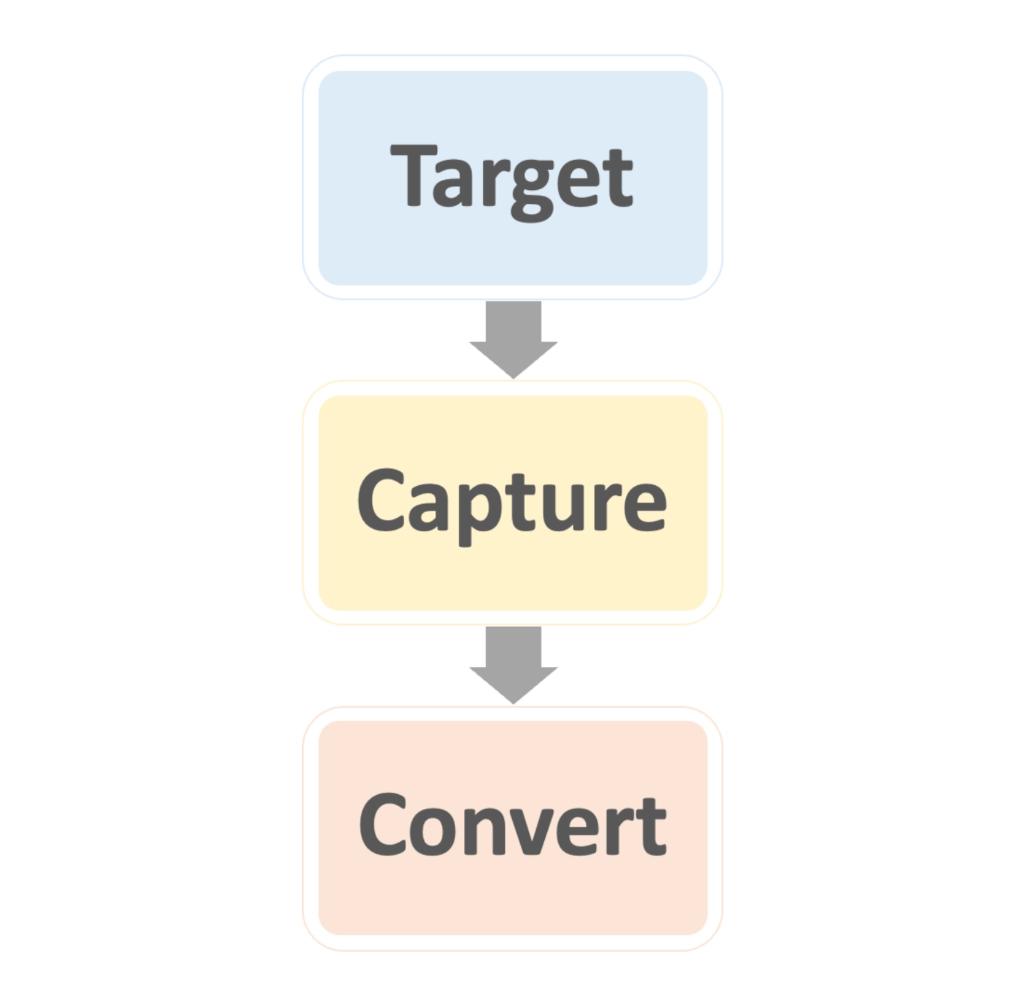
Offering Downloadable Resources
Offering downloadable resources such as eBooks, whitepapers or case studies continues to be a successful tactic for capturing contact information. When your visitors give you their email addresses in exchange for highly sought after content, that’s a win-win relationship.
A software technology company might be able to provide a deep case study. This case study shows the many ways their tool effectively addresses issues unique to the industry. It’s a truly effective tactic to bring in high-quality leads.
It sets up the business as an authority in their industry, which helps build trust with potential customers. To maximize reach, promotional efforts should extend to email campaigns, social media posts, and even paid ads on platforms like Google.
Features like gated resources, supported by clear CTAs, have proven effective at pushing visitors further down the funnel and getting them to take action.
Implementing Email Campaigns
Email marketing is one of the best ways to nurture your leads into future customers. By segmenting email lists, businesses can send targeted content that speaks directly to someone’s needs. Your audience is diverse.
For example, a fitness brand might design different PPC campaigns that cater to novice runners and seasoned athletes, keeping messaging relevant. Catchy subject lines such as “5 Easy Ways to Improve Your Performance” will help increase your open rates through the roof.
At the same time, short, direct email copy ensures leads are consistently engaged. Pairing email campaigns with website tracking tools like Leadfeeder ensures that you know who is showing interest, so you can follow up on the most interested leads.
Optimizing Landing Pages and Forms
A clear, user-friendly landing page is crucial to your lead generation efforts. Effective headlines, succinct copy, and compelling visuals all help visitors quickly grasp the value being presented.
Well-designed forms only ask for the details you need to know upfront, such as name and email, to avoid scaring off the user. A/B testing different layouts, calls-to-action, and page designs will show you what gets the best response from your audience.
A shorter form can improve performance for a free consultation lead gen offer. Conversely, a long form works better for higher-commitment assets such as webinars.
Running Lead-Focused Advertising
Paid advertisements on platforms like Facebook, Instagram and Google are effective tactics for lead generation that allow you to be as specific as your audience requires. These ads must have strong CTAs, such as “Download Your Free Guide Today,” and take users to targeted landing pages.
Monitoring ad performance is the only way to avoid wasting campaign dollars. By tracking click-through and conversion rates, you can identify which ads are producing the most effective outcomes.
This increased visibility enables you to pivot and optimize strategies that drive greater ROI.
Using Events to Capture Leads
Industry events, trade shows, and webinars provide exclusive platforms for in-person connections. In-person networking goes a long way in establishing authentic relationships that lead to quality leads down the road.
Having a booth presence at a major conference provides a unique setting for you to display your wares. Here, you can answer questions and gather contact information from potential customers.
Follow-up tactics such as tailored emails or special post-event discounts continue the engagement beyond the event itself. This leads to the first touchpoint resulting in more subsequent touches and increased conversions.
Choosing Between Demand and Lead Generation
When deciding between demand generation and lead generation, it’s essential to understand how each fits within your broader marketing strategy. While both approaches are beneficial for expanding your customer base, they each have different roles.
Demand generation builds recognition and generates curiosity about your brand. It usually does so by providing valuable educational resources, like webinars and blog posts. Lead generation is all about converting warm prospects into sales-ready leads. It usually achieves this by collecting contact information either through forms or calls to action (CTAs).
Ultimately, whether or not you choose demand or lead generation comes down to weighing a number of considerations that best fit your business objectives and capabilities.
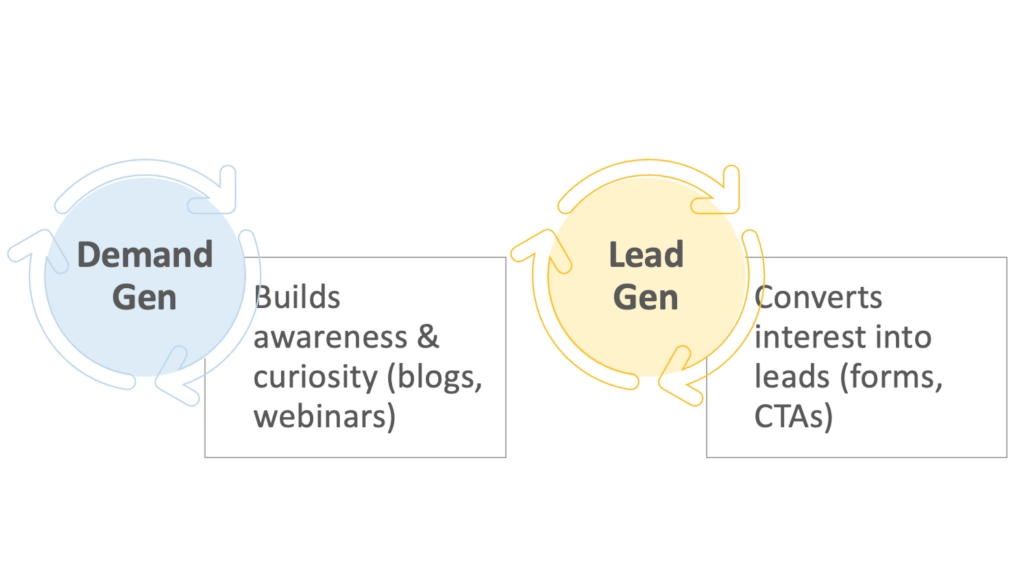
Evaluating Business Goals and Needs
Your goals determine which strategy to focus on. If your goal is to create brand awareness, you need to focus on demand generation. It’s the best option if you want to establish your business as a thought leader.
This strategy is effective for companies looking to capture interest at the very top of the sales funnel. Develop high-quality content to demonstrate your knowledge and experience. Webinars are a great way to bring in new potential customers that are at the beginning of their buyer journey.
If you’re trying to drive conversions or increase your customer list, lead gen is the key. As such, this strategy is more targeted and action-oriented, seeking to transform interest into measurable demand generation leads.
For example, offering a free resource like an e-book in exchange for contact details helps capture potential customers actively seeking solutions. Above all, be clear. By defining what success looks like for your business, you’ll be better able to choose the right strategy or even mix both together for a harmonious outcome.
Understanding Buyer Preferences
Today’s buyers are proactive, with 81% researching brands independently before contacting sales. Understanding their journey and customizing your strategy to their actions is key.
Demand generation usually focuses on providing content that informs and educates, helping buyers at every stage of their journey. More in Marketing Thought leadership agency articles or brand awareness campaigns help generate demand and can work well with audiences that value trust and expertise.
For lead generation, knowing what drives buyers to act is essential. This can involve everything from optimizing landing pages to developing personalized email nurture campaigns to better suit their needs.
Preferences and expectations change, so you must continue researching and iterating. By continuing to stay attuned to the needs of your audience, your strategies will stay effective and relevant.
Considering Budget and Resources
Budget is probably the biggest factor in deciding between demand or lead gen. Demand generation campaigns are more of a marathon that need ongoing campaigns and investment in content development, like creating a webinar or whitepaper.
Lead generation often requires more targeted spending—like running targeted advertisements or using lead capture tools. Putting people first by allocating resources wisely ensures those resources have the greatest impact.
Smaller businesses may prefer lead generation because it produces faster returns. Companies with the biggest budgets are more likely to be focused on long-term demand generation efforts.
Flexibility, too—being able to pivot your approach as budgetary resources shift will keep the ball rolling on your marketing strategy.
Key Metrics for Measuring Success
When measuring success between demand generation vs lead generation, knowing which metrics to look at is key. Metrics allow businesses to measure performance against defined goals, enabling them to adjust their marketing efforts and better align them with their overall business goals.
By honing in on the most appropriate data, companies can build upon their strengths, improve upon weaknesses, and find the sustainable growth they’re looking for. Below, I’ll provide further clarification on the metrics that are of highest importance for both demand and lead gen focused strategies.
| Metric | Demand Generation | Lead Generation |
| Primary Focus | Engagement, brand visibility | Conversions, lead quality |
| Key Metrics | ROAS, website traffic, brand awareness | Conversion rates, MQLs, SQLs |
| Cost Tracking | Cost per Lead (CPL) | Cost per Lead (CPL), cost per conversion |
| Performance Indicators | Social shares, ad impressions, video views | Form completions, lead quality scores |
| Impact Assessment | Content engagement, pipeline growth (up to 35%) | Lead-to-customer ratio, sales follow-ups |
Metrics for Demand Generation Success
Demand gen is all about creating awareness and generating interest in your brand. Key metrics such as engagement rates and brand awareness assist in measuring the effectiveness of campaigns in resonating with the target audience.
Monitoring your website traffic and social media impressions will show you how people are interacting with your content. Lastly, it’s an indicator of how effective your ads are.
Content marketing is a huge part of that. Metrics such as Return on Ad Spend (ROAS) and video engagement rates indicate how effective your strategies are. They allow you to judge how well your blogs, infographics, and webinars are working.
If one article continues to bring in consistent traffic, you know that people are connecting with that subject matter. This invaluable insight will tell you what makes them tick.
Ongoing analysis will help continually improve your demand generation strategies to bring in more qualified leads over time. By constantly monitoring CPL, ad performance, and social shares you can make sure you are using your resources in the most effective way.
Organizations see as much as a 35% increase in pipeline performance when they align their strategies. This underscores the importance of comprehensive tracking.
Metrics for Lead Generation Success
Lead generation is all about turning interest into hands-on business opportunities. Conversion rates, a fundamental metric, show how well prospects are flowing through the funnel.
For example, if you’re getting a higher form completion rate, that means your landing pages and your calls-to-action are working.
Lead quality matters just as much though. Metrics such as Marketing Qualified Leads (MQLs) and Sales Qualified Leads (SQLs) measure the quality of leads against profiles of your best customers.
MQLs may indicate early-stage interest, while SQLs often provide more detailed insights into a prospect’s needs, helping sales teams prioritize follow-ups.
CPL is another important metric, as it indicates overall campaign efficiency. A lower CPL with high-quality leads is a pretty good primer to return on investment.
By always tracking these metrics, marketers can maximize their tactics and increase overall lead conversion.
Aligning Metrics with Business Goals
Marketing metrics can be extremely powerful, but they are at their most impactful when they are tied to higher level business goals. If you want to increase revenue, focus on SQLs and lead-to-customer conversion rates.
This strategy ensures that marketing is always working in direct support of sales initiatives. Alignment builds accountability both within and between teams.
When performance metrics are linked to what the company is trying to achieve, measuring success becomes much simpler and allows for recalibrating strategies for the greatest impact.
Conducting regular reviews of the metrics you’re tracking will be key to ensure they remain relevant. Just as business priorities are continuously evolving, so too should the B2B SaaS benchmarks used to measure success.
Challenges in Demand and Lead Generation
Businesses face a different set of challenges with demand and leads. These challenges can have a huge cumulative effect on their marketing results. Both strategies are equally essential to your growth, but they demand different strategies to thrive.
Below, I’ll outline these common hurdles and ways you can address them, so you can avoid these pitfalls and find your way through the maze.
- Adapting to non-linear buyer journeys
- Avoiding resource misallocation
- Maintaining quality over quantity
By overcoming these challenges, businesses can improve their marketing efficiency and effectiveness, ultimately leading to more successful demand and lead generation efforts. Thoughtful, strategic planning is necessary to address these challenges. It’s what keeps our demand and lead generation efforts tight and effective.
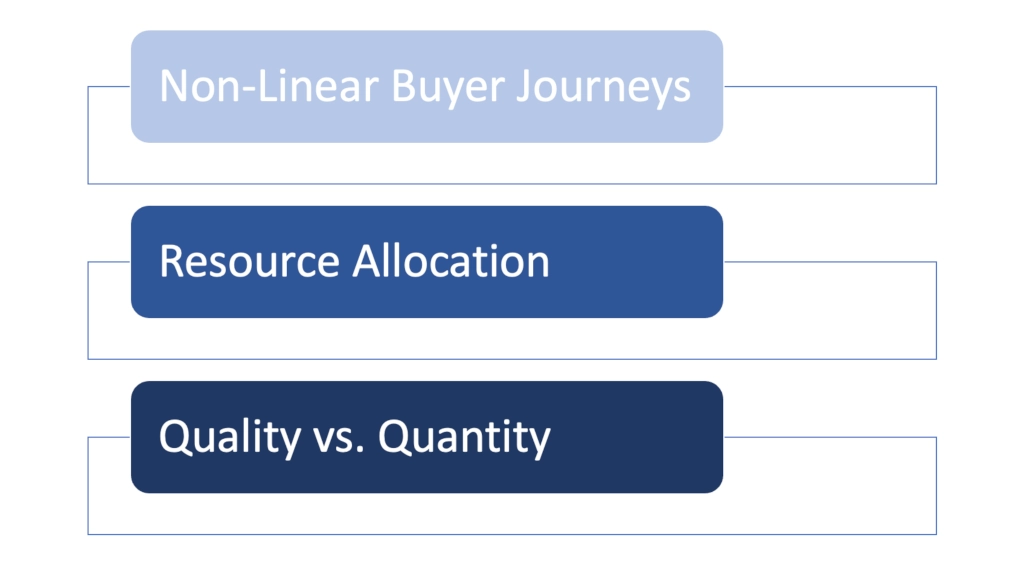
Adapting to Non-Linear Buyer Journeys
Today’s buyers follow less linear journeys to purchase. Today’s buyer journey is fluid and increasingly multi-dimensional. Users often reverse course, do deep research, and are swayed by multiple channels rather than progressing linearly down a classic funnel.
A new prospect journey often begins with exploring your website. They’ll read customer reviews and analyze your competitors’ videos before making the decision to contact you.
To adapt, businesses must have agile marketing plans that are in tune with these changed behaviors. Ongoing engagement during every step of the journey is key, since buyers often need several interactions before converting.
For instance, build awareness with educational content like blog articles or eBooks. By taking this approach you will deliver continued value while establishing trust with your audience. This is critical in demand gen, where creating awareness and credibility is the primary objective.
Avoiding Resource Misallocation
You just have to be smart about where you allocate your resources to maximize the impact of your marketing efforts. Without a clear set of priorities, it can be all too easy to overextend budgets or pour money into low-impact tactics.
Common pitfalls include over-focusing on vanity metrics like MQLs, which don’t necessarily translate to actual conversions, or neglecting demand generation efforts in favor of short-term lead capture.
Periodic evaluations are critically important to confirm that taxpayer resources are being utilized in the most effective and efficient manner. One of the more effective demand generation strategies I’ve encountered was developing in-depth, educational content specifically focused on the needs of our ideal customer profile.
This strategy brought in more than 2,500 leads. It delivered a cost per lead (CPL) of $47 – 33% more efficient than this time last year.
Maintaining Quality Over Quantity
By focusing on lead quality rather than just lead quantity, you’re much more likely to yield higher conversion rates and more sales. High-quality leads have a greater chance of being a good fit for your ideal customer profile (ICP) and moving along the sales funnel.
Target users who consistently visit your site and download materials, or chase them down after they’ve requested a demo. This method usually proves to be much more successful than pursuing huge volumes of unqualified leads.
We know that continual evaluation is the only way to ensure ongoing quality. Identify what channels drive in the highest value leads.
Refine your CTAs to focus on the different audience segments to help maintain the effectiveness of your efforts. Create deeper connections and better business outcomes with lead quality at the focus.
Conclusion
When you understand the difference between demand generation vs lead generation, you can create more effective marketing strategies. Each strategy plays a special part in expanding a company. Demand generation creates the awareness and interest. Lead generation is about taking that interest and driving actionable prospects. Together, they create a powerful combination for long-term growth.
The important part is matching these strategies to your objectives. Educate and engage your audience with demand generation. Use lead generation to find and nurture new leads until they’re ready to buy. Track metrics such as engagement rates, conversion rates, and ROI to identify what resonates best with your audience.
Finding the right balance of these two approaches will lead to the optimal results. Whatever your focus, begin by testing and learning, then iterate based on what the data shows. A detailed plan makes for more informed decisions and better results.
Frequently Asked Questions




